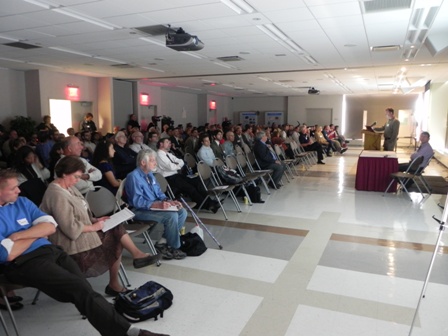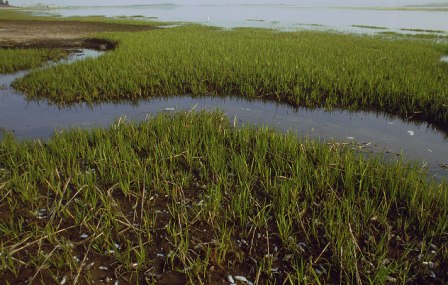Stony Brook, NY, November 11, 2011 - The focus of the "State of the Bay: Past, Present and Future—Revisited" symposium, held on October 20th at the Brooklyn College Student Center, was Jamaica Bay, a 39-square-mile estuary within a 142 square mile watershed that includes portions of Brooklyn, Queens and Nassau County. The event had nearly 200 attendees, a poster session highlighting student work and 15 presentations from leading scientists and researchers covering topics such as the Bay's environmental history, water quality improvements, green infrastructure demonstration pilots and salt marsh island restoration projects.
 October 2011's State of the Bay symposium at Brooklyn College Student Center attracted a full house. Photo courtesy of NPS.
October 2011's State of the Bay symposium at Brooklyn College Student Center attracted a full house. Photo courtesy of NPS.
The gathering was built upon discussions initiated in March 2004 at "Jamaica Bay's Disappearing Marshes," also a NYSG co-sponsored event. At that evening's session, held at the New York Aquarium in Coney Island, a Blue Ribbon Panel of scientists examined the factors causing the loss of the bay's salt marshes at a rate of 44 acres per year and what could be done to restore wetland loss. Later that year, NYSG and the National Park Service (NPS) produced a 55-page proceedings from the event, which can be downloaded via NYSG's Web site (
pdf).
"The panel's report provided a starting point from which the National Park Service and park partners could address the issue of wetland loss," said then-Gateway National Recreation Area Superintendent Billy G. Garrett. "Ultimately, protection of Jamaica Bay and conservation of its natural resources will depend on how well all of us understand the effect of urban systems on the bay and whether or not we choose to promote environmental health through our decisions and our actions. In other words, basic environmental stewardship is essential to the long-term health of Jamaica Bay."
Why all the concern over Jamaica Bay? It is a diverse ecological resource that supports multiple habitats, including open water, salt marshes, grasslands, coastal woodlands, maritime shrublands and brackish and freshwater wetlands. As cited by New York City's Department of Environmental Protection (NYCDEP), these habitats support 91 fish species, 325 species of birds and many reptile, amphibian and small mammal species. The bay is a critical stop for birds along the Eastern Flyway migration route and has become an internationally renowned birding destination. Portions of the bay, most notably the Jamaica Bay Wildlife Refuge, have been designated as Significant Coastal Fish and Wildlife Habitats by the federal and state governments.
 The health of Jamaica Bay is subject to the effects of being surrounded by millions of people.
The health of Jamaica Bay is subject to the effects of being surrounded by millions of people.
Stakeholders continue to look for ways to improve the conditions in the bay through research and transformation efforts. Photo courtesy of NPS.
Following in the footsteps of its predecessor, October 2011's "Revisited" day-long symposium "was an opportunity for people from different research labs, agencies, community groups, and concerned citizens to learn about ongoing research and to network to share ideas, concerns and develop and continue cultivating collaborations," said NYSG Research Program Coordinator Lane Smith, who was in attendance.
Identified as a strategy of the Jamaica Bay Watershed Protection Plan, "Revisited" is one in a series of symposia anticipated to occur every few years to highlight ongoing and emerging research on Jamaica Bay. It was partially supported by New York Sea Grant along with other partners, which included the National Park Service, New York City Department of Environmental Protection, Brooklyn College, and Brooklyn College’s Aquatic Research and Environmental Assessment Center."NYSG is proud to be part of a collaborative effort to bring together researchers and stakeholders to chart a resilient and sustainable future for Jamaica Bay and surrounding communities," said Smith.
About a week-and-a-half after the event, NYCDEP's Commissioner Carter Strickland announced the fourth phase of an eelgrass pilot project to help improve Jamaica Bay's local ecosystem. The project, which includes the addition of 8,000 eelgrass plants in Jamaica Bay near Breezy Point, will be followed with biweekly monitoring to track the health of the eelgrass, the ambient water conditions, and the impact of local wildlife on the project."This larger-scale planting is possible because of lessons learned from previous phases of the eelgrass project," said Strickland.
Eelgrass is a type of submerged aquatic vegetation that grows in estuaries and shallow bays. It is important for fish and shellfish as shelter and habitat. Eelgrass plants form meadows on the bay bottom, where aquatic creatures such as shellfish take shelter among the grass-like leaves. They also stabilize sediments, reduce erosion and naturally remove nitrogen from the water.
"Continuing our eelgrass plantings in Jamaica Bay is another important step in our efforts to improve this invaluable natural resource," said Strickland. "Until recently, the water quality in the bay made it impossible for eelgrass to survive, but years of investments in upgrading wastewater treatment make the reintroduction of eelgrass now possible. This work follows other major initiatives to improve the bay, like the historic agreement that Mayor Bloomberg announced last year with the State Department of Environmental Conservation, the Natural Resources Defense Council, and other environmental stakeholders to invest $115 million in nitrogen reduction technologies and marsh island restoration programs."
For more on this and other NYCDEP projects in Jamaica Bay, see their related news release (
pdf). And check out the NPS Web site (
click here) for audio of the keynote address at the "Revisited" symposium, by Dr. Denise J. Reed, "Seeking Sustainability for Estuarine Habitats in the 21st Century: Challenges and Opportunities," and a presentation by Dr. Eric J. Sanderson on his "NYC's Past, Present and Future Ecology" project.
New York Sea Grant is one of 32 university-based programs under the National Sea Grant College Program of the National Oceanic and Atmospheric Administration (NOAA), a cooperative program of the State University of New York and Cornell University. The National Sea Grant College Program utilizes this network of the nation's premier universities in conducting scientific research, education, training and extension projects designed to encourage science-based decisions about the use and conservation of our aquatic resources.